Archives
now browsing by author
The Language within Us
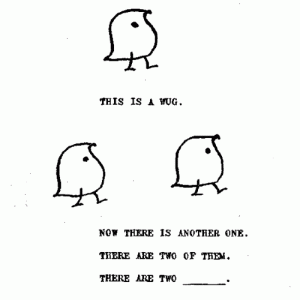
Language Acquisition
A very helpful link that gives an overview of language acquisition. It describes all the stages of language acquisition. It is very detailed and gives specific examples. Since this a website mainly for teachers teaching students acquiring a second language, it focuses mainly on the stages of second language acquisition rather than first. It also provides recommendations and ways to help the development of second language acquisition.
http://www.colorincolorado.org/article/26751/
Here’s a set of video lectures on Youtube that discusses a sub branch of psycholinguistics, language acquisition to be more specific. The first video talks about the role of language acquisition within cognitive linguistics and the specific stages involved. The second video goes into more detail about the main developmental aspects during the acquisition process such as the babbling, one word or two word stage. The last and third video is about the main driving forces in the language acquisition process and delves into innateness of language and factors that influence a child’s language.
https://www.youtube.com/watch?v=prMGbLrbudA&list=UUaMpov1PPVXGcKYgwHjXB3g
https://www.youtube.com/watch?v=_12OZGNGlPU
https://www.youtube.com/watch?v=rWmjpAlEqN0
Language Processing & Framing
Here’s an interesting video on how Google uses natural language processing for spelling corrections. Natural language processing has allowed for interactions between humans and computers. This process enables computers to derive meanings from human language input.
https://www.youtube.com/watch?v=Sx3Fpw0XCXk
A very thorough article about cognitive framing. It describes what frames are and discusses the importance of frames. It also provides different forms of frames and a diagram to help us better understand it.
http://www.beyondintractability.org/essay/framing
The following two links are also about framing. The first one talks about the framing effects while the second one is about the frame theory.
http://www.adsavvy.org/the-power-of-framing-effects-and-other-cognitive-biases/
http://www.csun.edu/~rk33883/Framing%20Theory%20Lecture%20Ubertopic.htm
Language in the Brain
A very simple yet informative video on the language areas of the brain and the effects of damage to those parts of the brain. It also talks about aphasia and split brain patients.
https://www.youtube.com/watch?v=lBqShvm4QRA
A website that talk about the types and causes of speech and language disorders. It also shows the areas in the brain that ar e affected in each disorder.
http://emedia.leeward.hawaii.edu/hurley/Ling102web/mod5_Llearning/5mod5.2_disorders.htm
This website goes into very specific details about the Broca’s, Wernicke’s and other language processing areas in the brain. It also includes a model of spoken language functions in the brain, discusses how handedness affects brain lateralization and how the right hemisphere contributes to language.
http://thebrain.mcgill.ca/flash/d/d_10/d_10_cr/d_10_cr_lan/d_10_cr_lan.html
Talks about what happens to the brain when we listen and speak and how we process these words to form a response.
Weee~ Field Trip
During my trip to the Museum of Man and Balboa Park, I noticed how many languages there were in the museum. When I first walked into the museum there was a whole section dedicated to beer. In that area, there was a whole wall with “beer” written in different languages on it and that was where I found most of the languages we were told to find such as Star Wars language, Greek, French, Lithuanian and Latin. Afterwards, I moved on to the area devoted to Mayan exhibitions where I found signs of the Mayan language. There was also a section dedicated to the Kumeyaay language on the second floor. Then when I went to the mummy exhibits I saw carvings and writings of Egyptian on the tombstones and coffins which I thought was pretty interesting. The only one language I couldn’t fine was the Yahi Language even though I walked around the whole museum but it was probably because I didn’t look careful enough. Other languages I found throughout the museum were Spanish of course, Chinese, Japanese and Korean. From this trip, I learned to saw beer in a lot of different languages but mot importantly I learned how linguistically diverse the world we live in is.
“What is your damage, Heather?”
The movie I’ve decided to watch with my friends was Heathers because we heard the movie was a 1980s version of Mean Girls. At the beginning of the movie I can see why some people say it’s an older version of Mean Girls because it’s about a regular high school girl who is invited by the most popular girls in school to join their clique. There were some elements that were similar to that in Mean Girls but as the movie went on, it got more confusing to me and believe me it’s nothing like Mean Girls. I actually had to watch the movie with subtitles on because I could hardly understand what the characters were saying. It’s true the film was in English but they used a lot of slang that we don’t hear a lot of in today’s world. Since the movie was made about 30 decades ago, the way teenagers spoke back then is way different from the way teenagers speak today. When we searched up the movie, we found out that it was suppose to be a comedy but we didn’t find it to be that funny maybe because we didn’t get any of the references made in the movie. Teens of the 80s probably enjoy that movie as teens of my generation enjoy Mean Girls because we actually understood the references made in the movies and found it funny. Throughout the movie, the characters swear at each other a lot but the way they phrase it sounded a bit weird to me. For example at the beginning, one of the Heathers say “Well, fuck me gently with a chainsaw. Do I look like Mother Teresa?” I don’t think anyone would say that nowadays and I’ve actually never heard a person say this phrase before. I also found phrases like “What’s your damage, Heather?” “Why do you have to be such a mega-bitch?” and “Veronica, why are you pulling on my dick?” (said by a girl) to be a bit strange to me but I got the gist of what it’s suppose to mean though. While watching the movie, I noticed the main character used an infix in a word when she was speaking to a friend she said “U.S fucking A” which reminded of Alafuckingbama, something we talked about in Ling class. 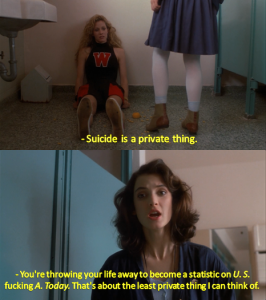
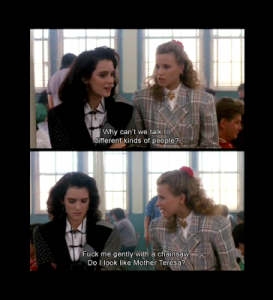

Morphology of Roy Lichtenstein’s Artwork
- What parts of the image do you see?
1st image: I see a blonde hair woman, tears streaming down a sad woman’s face, a thought bubble, a man in his suit and tie, and a yellow background
2nd image: I see a blonde hair blue eyed woman, tears streaming down a sad woman’s face, a thought bubble, words, and a bed or sofa
3rd image: I see a blonde hair blue eyed woman, a window, a thought bubble, staircase, and words
- How do those parts interact with each other?
1st: Since the man is in the thought bubble, the woman is obviously crying while thinking about him.
2nd: The woman is lying on a bed or sofa crying and thinking about something.
3rd: The woman is sitting beside a window that gazes at the nighttime city thinking about a man.
- Is this image telling a story?
1st: Yes the woman probably thinking about a loved one she’s lost or broke up with
2nd: Yes the woman is crying and thinking about how things should’ve been.
3rd: Yes the woman is wondering about where a man is at, probably a loved one
- Which parts of this image are characters in the story?
1st: The women is character of the story but the man can also be an important character since he’s the cause of the woman’s tears.
2nd: The women is obviously the subject or character of the story
3rd: Just like the previous images, the woman is also the character of the story
- Which parts of this image are crucial for the setting of the story?
1st: Not really a setting except a yellow background but it could probably mean she’s in a brightly lit room.
2nd: There’s not really much of a setting except for the couch/bed the woman is lying on
3rd: The window, night sky and skyscrapers create the background of the picture
- Which parts of this images are crucial for the plot?
1st: The crucial element is the women and the man in the thought bubble because it shows that thinking about the man make her cry.
2nd: The crucial element is the women and the words in the thought bubble because it shows us that she’s crying and regretting something.
3rd: The crucial element is the women and the words in the thought bubble because it shows us that she’s thinking about someone and wondering where he’s at.
- How do these parts interact?
1st: Shows that woman is thinking about a man she loves that has broken her heart
2nd: Shows that a women is lying in bed crying over a relationship probably that should’ve began another way.
3rd: Shows that its late at night woman is probably waiting for her man to come back hoe but he hasn’t come back yet so she’s worried.
- What parts of this image are “root” or “stem” parts and which parts feel like “affixes”? Why?
1st: The root of the image is the woman, the man in the bubble and the tears b/c they are crucial to the plot of the image. The affixes would be the colors, the tiny dots on the characters faces and the bold outlines.
2nd: The woman and her tears are the roots of the image because she’s the main character of the picture and the tears help show the emotion she’s feeling. The words inside her thought bubble is also the stem because it shows us what she’s thinking about that caused her to cry. The affixes would be the bed she’s laying on, the colors and the bold outlines.
3rd: The roots of the image is the woman and the words inside her thought bubble because it shows us that she’s thinking and concerned over someone. The windows, the buildings and the night sky are also the stem because they make up the background and setting of the image. Without it we won’t know that the woman is up late waiting for someone. The affixes would be the staircase, bold outlines, Ben-Day dots and colors because they kind of hold the hold image and brings it together.
- Of the affixes, can you say which are “inflectional” (they only exist to hold the grammar together) and which parts are “derivational” (they add some important information to the meaning, or change the kind of meaning of a given part)?
1st: I think the bold outlines and the Ben-Day dots on the characters faces are derivational. Without them, we’d not be able to see what the image is about because those are what basically make up the picture. The color of the picture however, is inflectional. Without colors, we will still be able to make out the important parts of the image such as the crying woman and the man in the thought bubble. The coloring just adds to the image but doesn’t affect the plot of the image.
2nd: The bold outlines on the picture are derivational because without them, we wouldn’t be able to make out what’s actually in the picture. For example without these black lines we probably won’t be able to tell that’s a woman’s face we’re seeing. Colors again is inflectional it’s just there to tell there to give the audience some extra details such as the woman has blonde hair and blue eyes but those are just minor details not crucial to the plot. The object the woman is laying on also is inflectional, it’s not really part of the background or anything and is just there to give the audience some extra details about the image. Without these inflectional affixes we will still be able to see what the woman is crying about.
3rd: The staircase would be inflectional because it doesn’t really do much to the image doesn’t tell us much about the story of the picture except the woman has a 2 story house. The bold outline, ben-day dots and colors however are what gives meaning to the picture and brings out the plot. The bold outlines and Ben-Day dots are derivational because they’re basically what forms the entire picture, without it we won’t be able to get a clear idea of what the picture is. The colors in this picture unlike the previous pictures are also an important part because the dark blue background outside the window lets us know its nighttime which is crucial for the plot.
10. Find what patterns repeat across the three images you’ve chosen.
All three images revolve around a sad women concerned about romance. In two of them the women are even crying over love. I assume they’re probably the same woman because they all have the same colored hair and in two of the images we can see that both woman have the same colored eyes. They’re probably also troubled for the same reasons by the same man. Another similarity is that the women are always thinking about something, hence the thought bubble. The art style of these images looks like what we’d see in comic books but there are no dialogues at all in these three pictures. The message these images are trying to send out is probably that women think too much and are always troubled by romance because they revolve their lives around men too much. Lastly the artist of these images tend to use the same colors to create these images. He mainly uses colors like yellow, red, blue and white which helps make the images pop out at people even more.
Gen 100 Calling a Significant Figure
For this assignment I called my cousin who was born and raised in Los Angeles. I decided to call my cousin instead of my parents because my parents can not speak English so calling him would fit the assignment more. I don’t see my cousin very often because he’s very busy the only times I get to see him are at family gatherings. While talking to him on the phone I didn’t pick up on anything new or surprising about the way he speaks. We had a very casual conversation, we talked about college and dorm life and he gave me a lot of advice since he has already been through college and is now getting his masters at USC. He started of the conversation with a “What’s up?” and “What’ve you been up to?” in which I replied “nothing much”. Since he grew up in southern California he rarely uses the word “hella,” even during our conversation. During our conversation, I asked him a serious of questions and found out that he says soda and bucket instead of pop and pail which is not very surprising in California. Being a 23 year old male college student he knows quite a lot of slang such as “swag”, “sick”, “dope” but he rarely uses slangs that I use such as “totes”, “adorbs” and “ratchet.” However, like me he has never heard of the words dank and flame which I think sounds kind of funny and weird. The vowels in pool and pull, feel and fill sound totally different to me. I also pronounce words such as bad,bat and bot differently. However, the words collar and caller sound the same to me and I say them similarly too.
Blog-1
Since I was born in China, I have quite some experience with different languages or shall I say dialects? Chinese is a language with many dialects so I grew up in a town that spoke one of those many dialects. Chinese has two mostly spoken dialects, Cantonese and mandarin. I grew up in a province where Cantonese was the main dialect spoken by everyone and also I watched a lot of Hong Kong television channels which were mainly in Cantonese so naturally I picked up on that as a second dialect. Then I attended a pre-school in China where I learned mandarin which became the third dialect I picked up on. After spending five years of my life in China I moved to America where I was exposed to a whole different language, English. I had learned some basic English in China by watching Disney movies and learning the alphabets at my pre-school but that was all. When I came to California I was put in the English Language Development class in first grade. I really don’t remember learning English to be a difficult task for me maybe because I came to America at such a young age. Being in this new English speaking environment, I learned to speak English pretty quickly and lost my accent. I’m really thankful for my parents for moving to America when I was so young, since it gave me more opportunities to be exposed to this new language. However I realized there’s also a downside to being exposed to a new language. After moving to Los Angeles I began to lose my mandarin speaking skills which is a shame because it’s the most spoken dialect in China but fortunately I am still able to understand it. Afraid that I won’t completely forget how to speak mandarin my parents sent me to a Chinese school where I learned how to read, write and speak it which did help me remember it. Then in middle school through high school I decided to challenge myself and took on Spanish. Up until now I have taken four years of Spanish but even after that I am still not confident enough to speak it. I remember my high school Spanish teacher told me something very interesting. She stated that people can only be able to produce sounds they have heard before a certain age, after that it will be very hard to learn. She said that to the class because everyone was having trouble rolling their “R.” She said that those who have not heard it before when they were young would have a hard time doing it but i don’t know if its true or not.
Two main languages are spoken in my household, Cantonese and a Chinese dialect that rarely anyone speaks even in China, the only people that I know of who speak this dialect are people from my hometown which is not very big. Occasionally I would speak English in my household but only to my little brother or cousins who were born in America. I don’t think I have ever experienced a time when language was a burden to me. In fact, knowing more than one language or being bilingual is an advantage because it gives me more opportunities to communicate with different people and understand them and this skill will become handy when I’m looking for a job in the future. However, there are times when I think being bilingual can be troublesome because I am always asked to translate letters in English for friends and family who don’t understand English and act as a translator, this can be a bit bothersome at times but I’m always happy to help anyone in need. Anyways this concludes most of my experiences with languages and I hope there will be more experiences to come.





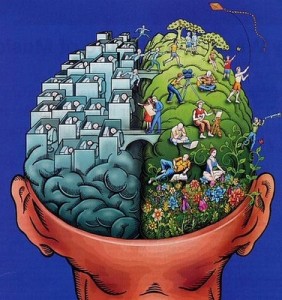








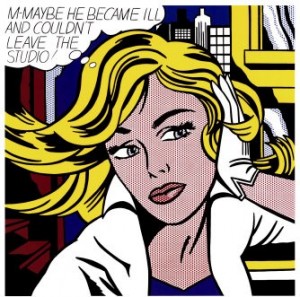
 D5 Creation
D5 Creation